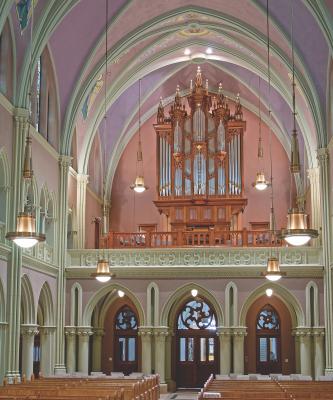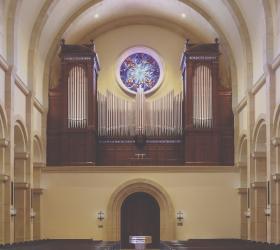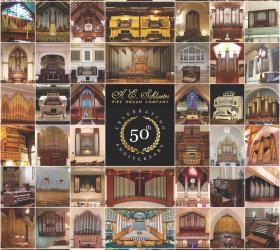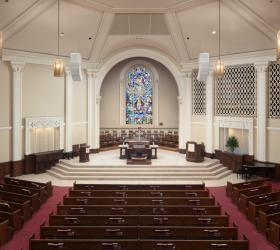
From the director of liturgy and music and the organ project advisor
On August 15, 1851, Katharina Kasper and four companions pronounced their vows as a new religious community, the Poor Handmaids of Jesus Christ (Ancillae Domini), and began their ministry to the poor, the sick, and those most in need. Under the shadow of a linden tree beside Heilborn Chapel in Dernbach, Germany, the congregation grew, and was called to minister all around the world. Today, Saint Katharina’s community serves in nine countries, including the United States, where the first motherhouse was established in 1868. The present motherhouse of the United States Province was dedicated in 1923 and is a thriving ministry center focused on serving the most vulnerable in society, a place of openness and welcome where people of all faiths and spiritual expressions can find a home.
At the center of life in the motherhouse is Ancilla Domini Chapel, a majestic building constructed to last for the ages and inspire countless searching souls. The chapel’s gallery first held the final organ by Louis Van Dinter, a Dutch-born organ builder who settled in Mishawaka, Indiana. The instrument was typical of those built for Catholic churches in the 1920s. It was relatively small, almost entirely composed of 8′ and 4′ stops voiced very smoothly, and designed to accompany the choir of sisters and play music during the Mass. It was never intended to lead the congregational singing that became common after the reforms of the Second Vatican Council. Like many such instruments, the Van Dinter was altered to suit the changing needs of the liturgy, but these renovations sapped the instrument of its original character and were made using low-quality materials. When the instrument began rapidly failing in the 2010s the need for a change became clear.
Respecting its history in the chapel, and recognizing its still-extant lovely core, we first considered renovating and expanding the Van Dinter organ. However, after considering several proposals, we ruled out this option. The necessary work was simply too extensive and making such an investment to yield a relatively unsatisfying result would not have been prudent. We also considered re-homing an existing instrument, but none were available that suited the needs of the project. A new pipe organ was the most economical and musically promising option.
Any new organ project requires assessing priorities. No one organ can play all literature compellingly or serve all needs equally. In Ancilla Chapel, the organ’s primary function is to accompany congregational singing. Particularly given the German heritage of the Poor Handmaids, our primary inspiration came from the great instruments of northern Europe, which were designed and built to accompany robust congregational singing. We desired a totally mechanical instrument of the highest quality, the kind of instrument that will stand the test of time and last as long as the breathtaking building housing it. This is in line with the Poor Handmaids’ commitment to integral ecology, sustainability, and true economy (which considers the timespan of generations, not simply the present moment). The new instrument also had to meet practical considerations: occupy a minimal footprint in the gallery, include modern playing aids (combination action, etc.), and fit within budgetary constraints. Given limitations of space and budget, a complete two-manual and pedal instrument was the best option to fulfill this vision. Finally, we desired a true musical instrument with its own integrity and identity, the kind of instrument that speaks to the soul and is more than an acoustical synthesizer of amalgamated tone colors.
After considering four proposals, in March 2019, the Provincial Council of the Poor Handmaids selected Taylor & Boody Organbuilders to build the new instrument. It was a difficult decision, since all the proposals were excellent and could have yielded wonderful instruments. Taylor & Boody’s proposal stood out for its attention to detail and spiritual connection to the Poor Handmaids. From the hand-drawn case design incorporating elements from the chapel architecture to the stoplist and specification, the proposal showed great care and commitment to the vision of the project.
Now that Taylor & Boody Opus 83 is installed and playing, we are proud to report that the vision has been fulfilled beyond expectations. When Saint Katharina sat praying under the linden tree by Heilborn chapel 150 years ago, could she have imagined that the linden wood from a tree by the motherhouse of her sisters an ocean away would adorn the case of a magnificent pipe organ? Perhaps she could, because, guided by the Holy Spirit, Saint Katharina’s faith and charism were rooted in something larger than herself: the God who surpasses all understanding, from whom untold graces can flow through those open to following the call to serve.
New pipe organs can never be about one person, or even one institution. These grand instruments are of and for the whole community, for all who encounter them. The Poor Handmaids of Jesus Christ are proud to offer Taylor & Boody Opus 83 for the glory of God and as an oblation to present and future generations. All are welcome to visit Ancilla Domini Chapel and play, hear, and pray with this splendid instrument.
—Andrew Jennings
Director of Liturgy and Music
United States Province, Poor Handmaids of Jesus Christ
—Dr. Benjamin A. Stone
Organ Project Advisor
From the organbuilders
George Taylor and Robbie Lawson first visited the Ancilla Domini chapel in February of 2019 while delivering our Opus 75, a continuo organ, to the University of Notre Dame. Their reaction was one of great surprise, to find such an imposing structure in so remote a location. They were struck by the quality of the building, the level of detail in the neo-Gothic architecture, and most of all, the room’s enveloping and generous acoustic. George recalls of their visit: “I asked Ben [Stone, the organ project advisor] to play a hymn on the 8′ Diapason. The turgid sound brought to mind E. Power Biggs’s put down (in his inimitable British accent) of a similar stop as ‘wooly.’ Then I went downstairs and asked Ben to repeat the verse. Thanks to the building those tubby old pipes now sounded lovely. Clearly, here we would be blessed with arguably the best room we had ever worked in.”
The towering case of the organ is modeled after 17th- and 18th-century Dutch instruments. It is constructed of white oak, much of which came from our sawmill, and stands at an imposing 34 feet tall to the top of the center spire. An aging and precariously leaning linden (basswood) tree that had to be removed from the Ancilla Domini campus was sent to our sawmill, and supplied the lumber for the carvings, providing a very special connection between the organ and its home. All of the case decoration is reflective of the sanctuary, and especially its beautiful and ornate high altar.
The façade contains pipes from the Hauptwerk 16′ Principal, down to low F-sharp, as well as the Oberwerk 8′ Principal. Behind it, at impost level, sit the two large windchests of the Hauptwerk division. Located above that, in the center, are the Oberwerk windchests. The Pedal is housed in a separate, two-tiered open case that stands behind the main case. The vaulted ceiling above the organ is the perfect reflector not only for the encased manual divisions, but likewise allows for the Pedal to stand behind the case without any loss of tonal presence.
Though the focus of many of our recent instruments has been toward the accompaniment of choirs and congregations in an Anglo-American style, with complete Swell divisions behind foundational Great choruses, we were asked for this project to return to a more pure form of the idiom in which we have worked for many decades, that of the high North German Baroque organ. This perfectly suits their primary requirement of robust congregational accompaniment in a large, reverberant room.
Far from being a collection of screeching mixtures, the opulent specification provides a variety of 16- and 8-foot stops in each division, as well as complete choruses and a plethora of flutes and mutations. The Oberwerk’s high-tin 8′ Principal in façade is modeled after 18th-century examples, and its instrumental speech is the perfect foil to the Hauptwerk’s hammered lead 8′ Octave, whose dark, vocale sounds recall an earlier era. The Hauptwerk is lent gravitas by its full-compass 16′ Principal. The high bass response of the room allows the largest pipes to speak naturally and gently, completely unforced. The 8′ Holzflöte of the Oberwerk is a tapered wooden stop that sings with an ethereal charm from its position high atop the organ. The 8′ Salicional of the Hauptwerk has more refined speech characteristics than some of its Baroque cousins, but there is still plenty of rosin on the bow.
Perhaps more so than the brilliant choruses, it is the variety of reeds that distinguish the North German Baroque organ, and Opus 83 is no exception. The German-faced shallots help relate the sound of the dark and covered Trompets of the Hauptwerk to the brash and noisy 8′ Trompet that cries from the Oberwerk. The room demands a 32-foot pedal reed, and our Pedal Fagott can be heard under full organ, or used under just 8-foot stops. The woody and clarinet-like Dulcian, the strident Vox Humana, and the piquant Cornett provide an array of accompanimental and solo possibilities.
The key and stop action of the organ are completely mechanical, though the utility of the organ has been augmented by a combination action and sequencer by Solid State Organ Systems. Carbon fiber trackers are used throughout the instrument. The wind for the organ is provided by three large wedge bellows, located in a room behind the back wall of the gallery. The entire organ plays on 80mm (31⁄8 inches) wind pressure. Though normally blower-winded, the organ can also be foot-pumped. The tremulant affects the entire organ, and wind stabilizers can be engaged to calm the lively wind.
The first truck of organ parts arrived the week before Thanksgiving of 2022, and the last tuning cone was packed up three months later near the end of February. Tonal finishing was completed by Aaron Reichert and the author, assisted by Sean Dye. I would be remiss if I did not mention the wonderful hospitality extended to us during installation and voicing. The organ was dedicated in a service of blessing on March 25, 2023, followed by a recital played by organ project advisor Dr. Benjamin A. Stone. The sisters have truly fostered a friendly and welcoming community, and it was a true joy to work with them, Ben Stone, and Andrew Jennings in bringing this instrument to life!
—Joel A. VanderZee
Taylor & Boody Organbuilders
HAUPTWERK (manual I)
16′ Principal
16′ Quintadena
8′ Octave
8′ Rohrflöte
8′ Salicional
4′ Octave
4′ Spitzflöte
2-2⁄3′ Quinte
2′ Superoctave
Mixture IV–VI
Cornet IV (mounted, gº–d′′′)
16′ Trompet
8′ Trompet
OBERWERK (manual II)
8′ Principal
8′ Gedackt
8′ Holzflöte
4′ Octave
4′ Rohrflöte
2-2⁄3′ Nasat
2′ Octave
2′ Waldflöte
Sesquialtera II
Scharff IV–VI
16′ Dulcian
8′ Trompet
8′ Vox Humana
PEDAL
16′ Principal (HW)
16′ Subbass
8′ Octave
4′ Octave
Mixture V
32′ Fagott
16′ Posaune
16′ Trompet (HW)
8′ Trompet
2′ Cornett
Couplers: OW to HW, HW to PD, OW to PD
Tremulant, Zimbelstern, Wind Stabilizer
Metal pipes of hammered lead-tin alloys
Natural keys of polished cow bone
Sharps and stop knobs of ebony
Mechanical key action
Mechanical stop action with combination capture system and piston sequencer
Manual compass: C–a′′′, 58 notes; Pedal compass: C–f′, 30 notes
Case of solid white oak
Three wedge bellows with foot pumping levers and blower
Temperament: T&B’s “Ancilla”
Pitch: A=440hz at 70ºF
36 stops, 52 ranks, 2,486 pipes
T&B’s “Ancilla” Temperament offsets from Equal in cents:
C +5.87 C-G -1/6 PC
Cs -1.30 G-D -1/6 PC
D +1.96 D-A -1/6 PC
Ds +2.61 A-E -1/9 PC
E -0.65 E-B -1/6 PC
F +6.52 B-Fs -1/9 PC
Fs -3.26 Fs-Cs 0
G +3.91 Cs-Gs 0
Gs +0.65 Gs-Ds 0
A 0.00 Ds-As 0
As +4.56 As-F 0
B -2.61 F-C -1/9 PC




